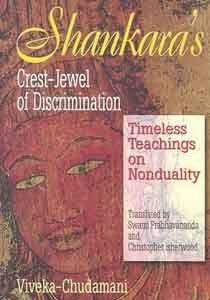Translator Madhavananda (1921) Published in English Madhavananda (1921) Subject Hindu philosophy | Country India Pages 503 pages Language Sanskrit Genre Advaita Vedanta | |
 | ||
Publisher Original: 8th century AD; Reprinted by Bharatiya Vidya Bhavan, Mumbai Similar Brahma Sutras, Atma bodha, Panchadasi, Bhaja Govindam, Mandukya Upanishad | ||
The Vivekachudamani (Sanskrit: विवेकचूडामणि) is a famous Sanskrit poem ascribed to Adi Shankara in the eighth century. It expounds the Advaita Vedanta philosophy and is in the form of 580 verses in the Shardula Vikridita metre. The Vivekachudamani describes developing Viveka, the human faculty of discrimination or discernment between real (unchanging, eternal) and unreal (changing, temporal), as the central task in the spiritual life, and calls it the crown jewel among the essentials for Moksha. The title Vivekachudamani translates to Crest Jewel of Discrimination. Through the centuries, the Vivekachudamani has been translated into several languages and has been the topic of many commentaries and expositions.
Contents
Shri adi guru shankaracharya s vivekachudamani part l
Authorship
The authorship and origin of Vivekachudamani has witnessed a discussion. The broad consensus, according to John Grimes, is to credit the text to Adi Sankara.
Contents
Vivekachudamani consists of 580 verses in Sanskrit. It has the form of dialogue between the master and the disciple, where the master explains to the disciple the nature of the Atman and the ways to research and know the Atman. The book takes the disciple on a step by step instructions to reach Brahman.
The text begins with salutations to Govinda, which can be interpreted either as referring to God or to his guru Sri Govinda Bhagavatpada. It then expounds the significance of Self Realisation, ways to reach it, and the characteristics of a Guru. It criticizes attachment to the body and goes to explain the various Sareeras, Kosas, Gunas, Senses and Pranas which constitute the Anatman. It teaches the disciple the ways to attain Self-realisation, methods of meditation (dhyana) and introspection of the Atman. The Vivekachudamani describes the characteristics of an enlightened human being (Jivanmukta) and a person of steady wisdom (Sthitaprajna) on the lines of Bhagavad Gita.
Commentaries
There are two Sanskrit commentaries on this work. Sri Sacchidananda Shivabhinava Nrusimha Bharati, the pontiff of Sringeri, wrote a commentary titled Vivekodaya (Dawn of Discrimination) on the first 7 verses of this work. His disciple, Sri Chandrasekhara Bharathi, has written a Vyakhya or commentary on the first 515 verses of this work.
This work has been repeatedly translated into various languages, often accompanied by a commentary in the same language. English translations and commentaries include those by Swami Prabhavananda and Christopher Isherwood, Swami Madhavananda, and Swami Chinmayananda. Tamil translations and commentaries include those by Ramana Maharshi. Swami Jyotihswarupananda has translated the Vivekachudamani into Marathi.
Famous verses
Translation: Brahman is the only truth, the world is unreal, and there is ultimately no difference between Brahman and individual self
Translation: By reflection, reasoning and instructions of teachers, the truth is known, Not by ablutions, not by making donations, nor by performing hundreds of breath control exercises.
